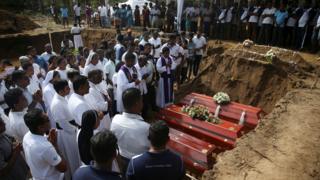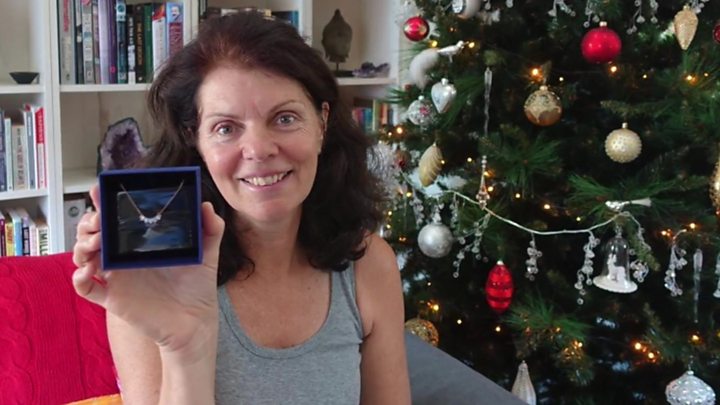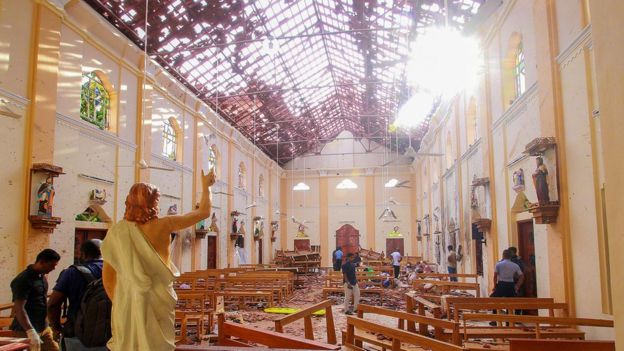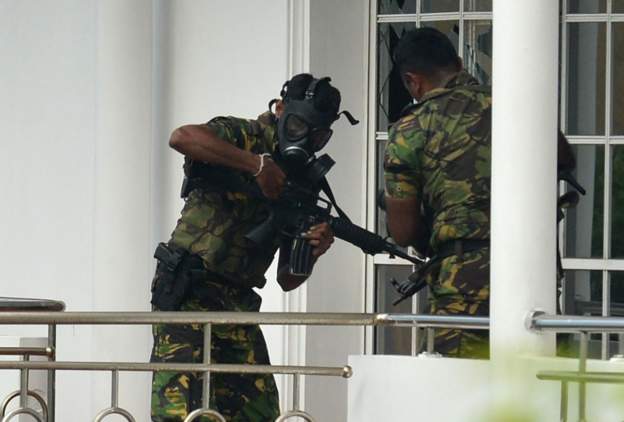Sri Lanka attacks: Mass funeral on day of mourning
 Image copyright Reuters
Image copyright Reuters The first mass funeral has begun in Sri Lanka as the country marks a day of mourning for the victims of Sunday’s bomb blasts.
The death toll of the attacks on churches and hotels has increased to 310, police said on Tuesday.
The country has observed three minutes of silence and a state of emergency is in effect to prevent further attacks.
Sri Lanka’s government has blamed the blasts on local Islamist group National Thowheed Jamath (NTJ).
Police have now detained 40 suspects in connection with the attack, a spokesman said Tuesday.
The mass funeral is taking place at St Sebastian’s church in Negombo, north of Colombo, which was one of the places targeted in Sunday’s blasts.
Earlier, a moment of silence was observed at 08:30 (03:00GMT), reflecting the time the first of six bombs detonated.
Flags were lowered to half mast and people bowed their heads in silence in respect to the victims as well as the 500 people injured during the attacks.
The state of emergency gives police and the military sweeping powers to detain and interrogate suspects without court orders – powers that were last used during the nation’s civil war.
The government blocked access to Facebook, WhatsApp and Instagram after the blasts.
NTJ, the group named by the government as the main suspect, has no history of large-scale attacks but came to prominence last year when it was blamed for damaging Buddhist statues.
However, neither NTJ, nor any other group, has admitted carrying out Sunday’s bombings.
Warnings ignored
Since Sunday, scrutiny has fallen on the rifts in Sri Lanka’s leadership, after it emerged authorities were warned about an imminent threat.
Security agencies had been watching the NTJ jihadist group, reports said, and had notified police about a possible attack.
But the prime minister, Ranil Wickremesinghe, and the cabinet were not informed, ministers said.
A rift between Prime Minister Wickremesinghe and President Maithripala Sirisena was why Mr Wickremesinghe has not been receiving security briefings, cabinet spokesman Rajitha Senaratne said.
It was not clear on Monday whether Mr Sirisena had been made aware of the warnings. “Our understanding is that it was correctly circulated among security and police,” Shiral Lakthilaka, a senior adviser to Mr Sirisena, told the BBC.
He said that the president had appointed a special committee led by a supreme court judge to investigate what had happened.
How did the attacks unfold?
The first reports of explosions came at about 08:45 local time on Sunday with six blasts reported within a small space of time.
Police did not release a breakdown of how many people were killed and wounded at each location.
All the attacks were carried out by suicide bombers, officials said.
Who were the victims?
Most of those who died were Sri Lankan nationals, including scores of Christians attending Easter Sunday church services.
The ministry of foreign affairs said it had identified 31 foreign nationals among the dead, with 14 unaccounted for. The death toll included at least eight British citizens and at least eight citizens of India.

Media playback is unsupported on your device
They include three of the children of Danish billionaire Anders Holch Povlsen, a family spokesman confirmed to the BBC. Mr Povlsen owns the Bestseller clothing chain and holds a majority stake in clothing giant Asos.
British lawyer Anita Nicholson died alongside her two children, Alex, 14, and Annabel, 11, when a suicide bomber detonated a device in the breakfast queue at the Shangri-La hotel in Colombo.
Her husband, Ben Nicholson, survived and praised his “wonderful, perfect wife” and “amazing, intelligent” children.
China on Tuesday issued an advisory to its citizens not to travel to Sri Lanka in the near future while the US State Department had already on Sunday warned of possible further attacks in a travel advisory.







